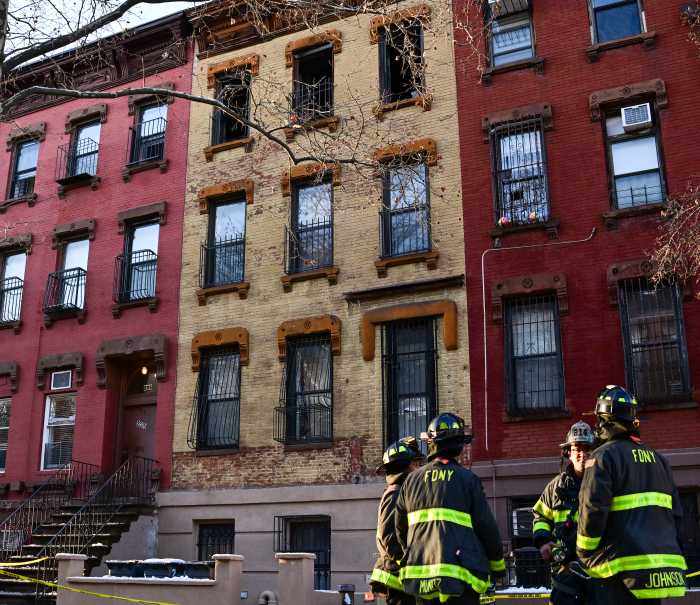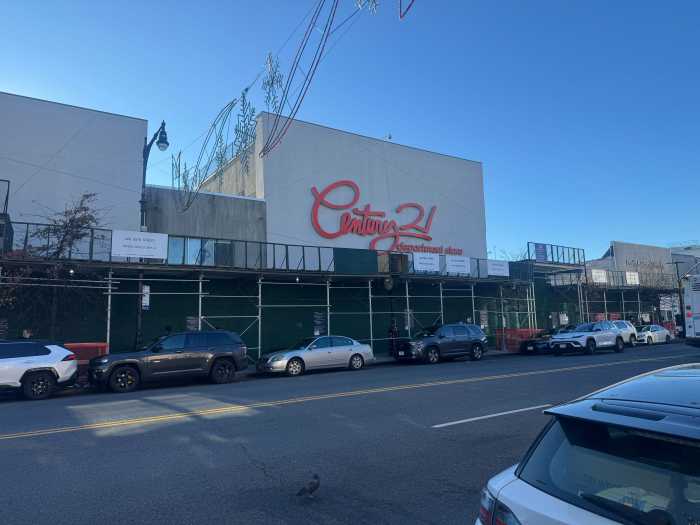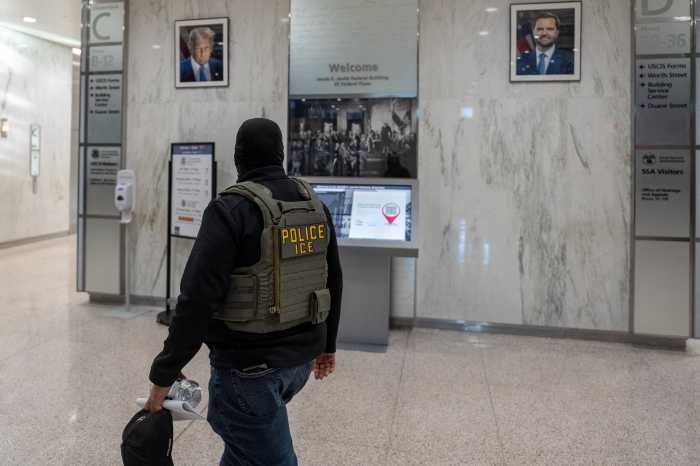It took mere seconds after the Pledge of Allegiance to get a sense of how Community Board 15’s general board meeting would unfold last Tuesday night. As soon as attendees lowered their right hands from their hearts, a few began chanting, “No batteries!”
Chairperson Theresa Scavo attempted to quiet the small group, members of the volunteer organization Protect Our Children New York (POCNY). A brief back-and-forth followed, with the group saying they — and many others — were there solely for the presentation and protest of a proposed lithium-ion battery energy storage site at 2481 McDonald Ave. in Gravesend.
After a few minutes, the arguing subsided, allowing CB 15’s meeting to officially begin.
Gravesend is the latest Brooklyn neighborhood facing plans to install a lithium-ion battery energy storage system near residential areas and other locations residents say are unsafe for such facilities. Marine Park is another neighborhood where residents, business owners and community leaders have expressed outrage and fear over the systems being placed so close to homes and businesses. Both communities are also frustrated that they were not notified about the sites before plans for installation were approved.
Similar concerns are unfolding across New York City, including in Middle Village, Queens, and northern Staten Island. The storage systems are part of New York State’s broader push to decarbonize and transition to renewable energy, moving away from aging and polluting peaker plants. Officials also say the systems could help lower utility bills amid rising electricity use and advancing technology.
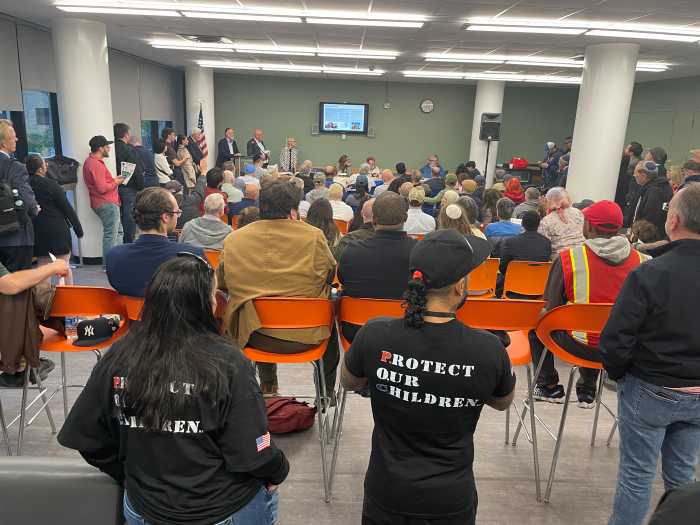
But concerns over fire safety and potential health risks have left many New Yorkers — including Brooklyn residents — skeptical, if not outright opposed. Protests and contentious community meetings have followed. Late last week, Staten Island Borough President Vito Fossella announced plans to file a lawsuit to halt construction of the sites in the borough.
Amid growing frustration across the city, CB 15’s meeting Tuesday marked another chapter in the ongoing debate over energy upgrades — and how much say residents have in the process.
Soltage extends an olive branch
The battery energy storage site in Gravesend is being developed by Soltage, a renewable energy company based in Jersey City. On Tuesday, Soltage’s senior vice president of storage development, Dirk van Ouwerkerk, gave a presentation on the McDonald Avenue site and apologized to the dozens of attendees for not engaging the community earlier.
“The first thing I want to do in front of this entire room is apologize,” van Ouwerkerk said while opening his presentation. “[I want to] apologize for the fact that we had not anticipated that there would be questions and concerns, and I will explain to you why that was the case. I’m a Dutchman, I’m from the Netherlands. The highest on my bar in honesty. I understand your concerns and we do not want to force anyone. We are not here to throw the battery out and run away with the profit.”
Soltage has been in the renewable energy sector for more than 20 years, developing projects in New York, New Jersey and Massachusetts. According to van Ouwerkerk, the company has 15 lithium-ion battery storage projects across Brooklyn and Queens — including in southern, central and northern parts of Brooklyn. He explained that homes, businesses and municipal buildings are increasingly reliant on electricity, and as technology advances — with new devices, electric vehicles and artificial intelligence — demand continues to rise, putting added strain on the city’s decades-old peaker plants.
“You’re running out of power,” he said. “I’m telling you, you’re running out of power.”
Van Ouwerkerk also addressed three incidents nationwide where similar lithium-ion battery storage systems caught fire and caused injuries or illnesses. He said the fires — in Warwick, New York; Monterey County, California; and Phoenix, Arizona — occurred because the systems either didn’t meet New York City’s fire safety standards or, in California’s case, were located indoors, unlike the planned outdoor setup in Gravesend.
He also responded to concerns about property values, noting that the buildings bordering the McDonald Avenue site contain asbestos and the surrounding soil has become toxic after decades of industrial use. Van Ouwerkerk said Soltage plans to demolish those buildings, remove the contaminated soil, and replace it with clean topsoil.
Van Ouwerkerk insisted he would oppose the storage systems himself if he didn’t have the information to understand their purpose, how they operate and how safe they are. He added that Soltage’s work was a “force for the good,” noting the company is investing millions into the McDonald Avenue site.
In the event of a fire
Despite the presentation and accompanying PowerPoint, many attendees remained unconvinced the site would be safe. Some pointed out that van Ouwerkerk failed to mention the location sits directly beneath elevated train tracks used by the F train, and that the numerous support columns could obstruct firetruck access — raising concerns about what would happen if the storage system caught fire.
Van Ouwerkerk said Soltage has been in communication with MTA engineers for three months, and that they assured the tracks would not be affected. He acknowledged the location is tight for emergency vehicles and admitted he did not know how many firetrucks could fit between the columns. He added that Soltage has been in contact with the FDNY for the past nine months.
Questions arose about who would monitor the batteries to ensure nothing goes wrong. Van Ouwerkerk explained that while the FDNY does not directly monitor lithium-ion batteries, the system would be overseen by an organization made up of former FDNY members, whom he said he has known for years. Soltage and the battery manufacturers would also monitor the site’s voltage, temperature and frequency. If an issue arises, both the FDNY and Soltage’s Certificate of Fitness holder would be alerted, and Soltage would shut down the system. A follow-up investigation and study of the affected battery module would then be conducted.
Van Ouwerkerk appeared to stumble over his words as the discussion repeatedly returned to the potential for fire. He told the crowd the FDNY was “not very worried” about the homes behind the McDonald Avenue site catching fire, “believe it or not.” He added that the FDNY maintains high safety standards and said that none of the products Soltage plans to use — which are also in use at similar sites nationwide — have caught fire.
“It’s not very likely to happen,” Van Ouwerkerk said. “But if the battery cell heats up, we’re going to see that it heats up. We’re not going to wait until it catches fire — we’re going to stop it from catching fire. If it then catches fire, then we’re there on time to cool everything so it doesn’t propagate.”
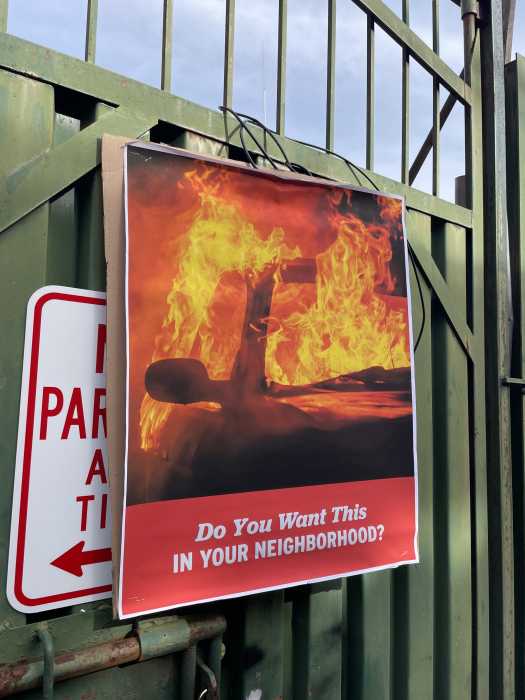
He added that Soltage’s approach to fire prevention and response would differ from NineDot’s — the developer behind the Marine Park site — because Soltage uses a different type of lithium-ion battery system.
Additional concerns were raised about the possibility of the internet going down, which could disrupt monitoring and increase the risk of a fire breaking out and spreading toxins into the air. There were also questions about how quickly the Certificate of Fitness holder could arrive at the site if coming from Jersey City. Van Ouwerkerk’s response — that the holder was “technically supposed to be there in two hours” — was met with scoffs and laughter.
Anger rises
Frustration reached a fever pitch when Ron Canterino, president of New Yorkers First, confronted Van Ouwerkerk and engaged in a heated argument with the board’s first vice-chairperson, Ronald Tawil, who had told Canterino to give Van Ouwerkerk a break. Chairperson Theresa Scavo attempted to de-escalate the situation, but tensions boiled over into a protest.
Members of POCNY began chanting, “No batteries!” and “This is about our grandchildren.” Peter DiMiceli, founder of POCNY, approached the podium and told Van Ouwerkerk there were plenty of other locations for the storage systems. DiMiceli, who two weeks ago handcuffed himself to a planned battery site on Staten Island, invited Van Ouwerkerk to visit the borough and meet with concerned residents.
“You’ll get one hell of a welcome,” DiMicel said. “We’re not as nice as Brooklyn. And I would lock myself up against your site.”
Van Ouwerkerk told him Soltage has no projects on Staten Island.
The chaos continued as Canterino and other members of POCNY shouted taunts at Van Ouwerkerk, asking how he could sleep at night. Scavo struggled to restore order, which took several minutes.
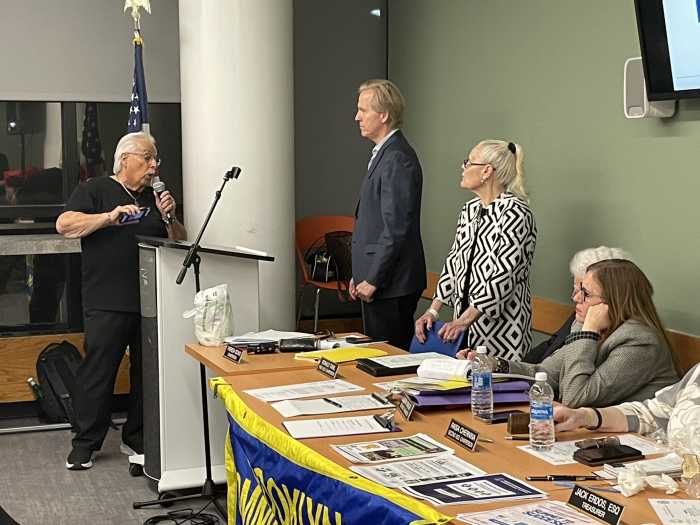
The community board votes
More concerns were raised once calmness came, including fears about cancer risks and radiation. Former City Council Member Ari Kagan — now running to reclaim the seat in the upcoming primary — criticized Soltage for failing to consult with community boards or elected officials before choosing the McDonald Avenue site.
Current District 48 Council Member Inna Vernikov did not attend the hearing but sent representatives from her office in her place.
“I have been a vocal opponent of this facility for two very important reasons: first, because lithium-ion batteries have a well-documented history of causing fires and damage to life and property; second, because it’s obvious that the community does not want this in their neighborhood,” Vernikov said in a statement to Brooklyn Paper. “This trend of the city government allowing projects to steam forward despite clear community concern and opposition must end. I refuse to stand by silently just because it’s not happening directly in my district — especially since I know that it could easily come to my district and directly affect my own constituents. This is a citywide issue and the people deserve an advocate.”
Van Ouwerkerk wrapped his presentation by saying he believes New Yorkers deeply trust the FDNY, and if the department approves the storage sites, they must be safe. Several attendees, however, expressed skepticism, saying Van Ouwerkerk sounded disingenuous and had failed to answer many questions.
Shortly afterward, CB 15 held a vote and unanimously opposed the site.
When asked about next steps, Scavo told Brooklyn Paper that the board will alert its reps, as well as the New York City Economic Development Corporation. “We will also try to work with our elected officials to stop this from happening,” she said. “Possibly help them find an alternate site.”
Scavo added that the board will look into the community’s cancer concerns.
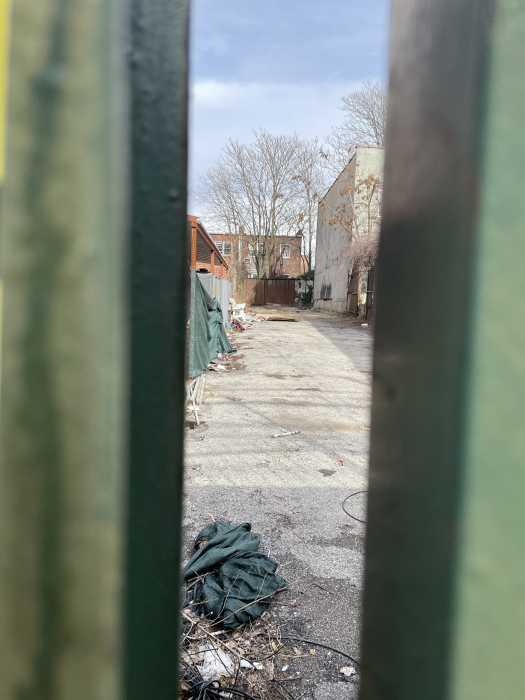
Gregory Kirsopp, chief of staff for Assembly Member Michael Novakhov, whose district also includes Gravesend, said Novakhov is not opposed to lithium-ion battery storage systems but is concerned about their location. Kirsopp also suggested helping Soltage find an alternative site.
Van Ouwerkerk acknowledged he expected a hostile environment going into the presentation, but emphasized that the goal was to inform residents about the critical need for the storage systems.
“We believe in it and it’s safe,” he said. “A lot of leaders know we need batteries. I’m optimistic people will come around.”
When asked about the tension and shouting during the meeting, Scavo said, “I understand their passion. They are fearful!





